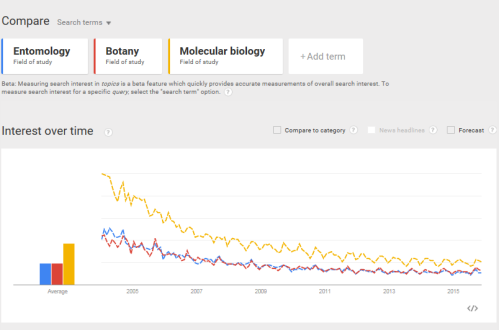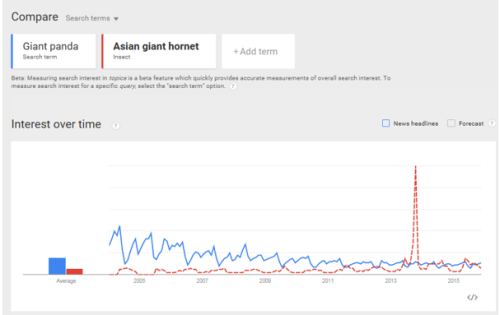No doubt I am behind the curve, but I have only recently discovered Google Trends; a result of attending a Departmental seminar given by a colleague talking about Biochar!
To quote Wikipedia “Google Trends is a public web facility of Google Inc., based on Google Search, that shows how often a particular search-term is entered relative to the total search-volume across various regions of the world, and in various languages. The horizontal axis of the main graph represents time (starting from 2004), and the vertical is how often a term is searched for relative to the total number of searches, globally.” I was greatly taken by my colleague’s slide showing the birth and development of a new concept
and wondered if this would be a useful tool to look at some entomological topics. Immediately after the seminar I rushed back to my office, and as you may have guessed, entered the word “aphid” into the search bar and was, after a bit of computer chuntering, rewarded with my first Google Trend output 🙂
I was immediately struck by how closely this resembled real aphid population
data, albeit a more regular and smoother than these examples of real data. I found that if you ran the cursor along the data lines the month was displayed, and as I expected, the peak in aphid interest was generally June and May, reflecting their peak abundance in the field. I next entered
“Ladybird” to see if it coincided with aphid peaks and interestingly found that it had two peaks within each year, May, when they start to become active and October when they start to look for hibernation sites, so as with aphids, the frequency of the search term usage reflects biological activity. “Butterfly” and “Ant” as search terms revealed that interest in ants and butterflies has remained
fairly constant over the last decade or so, although somewhat to my surprise, ants have had proportionately more searches than butterflies. Given my worries about the declining interest in plant sciences and the funding problems facing
entomology, I thought it might be educational to compare botany and entomology.
Not an encouraging picture, although at least the decline has plateaued out. Then, just in case, as in many universities, Botany departments have been replaced with Plant Science departments, and is now taught under that title,
I substituted “Plant Science” for “Botany” and was surprised to see that “Entomology” was searched for about twice as many times as “Plant Science”.
Comparing “Botany” with “Plant Science” reveals that “Botany” was searched for considerably far more than “Plant Science”, despite most universities no longer having Botany Departments. Perhaps they should reconsider their decision to do away with the title?
Keeping with the subject theme and having written in the past about how molecular biology has gained funding and kudos at the expense of whole organism biology (Leather & Quicke, 2010) I compared “Entomology” with
“Botany” and “Molecular Biology” to find, that although overall “Molecular Biology” beats both subjects, interest in the subject has also declined over the last decade. One of my bugbears is the amount of interest and funding that the so called “charismatic mega-fauna” gain at the expense of, in my opinion, the much more deserving invertebrates.
I therefore compared “Giant Panda”, with “Insect” and “Entomology” and was pleasantly surprised to see that “Insect” wasn’t quite overshadowed by “Giant Panda” although somewhat saddened to see that the whole discipline of “Entomology” was not overly popular.
I confess that felt a little frisson of delight when I found that in recent years “Asian giant hornet” has been giving the “Giant panda” a bit of competition 🙂
Recently there has been huge debate over the use of neonicotinoids and their possible/probably part they may have in the decline of bees of all sorts (Jeff Ollerton’s blog is a good place to follow the latest news about the debate), so I used “Bee” “Bumblebee” and “Neonicitinoid” as search terms and was
surprised to find that “Neonicitinoid” in this context has not really had an impact, although if you search for “Neonicitinoid” by itself you
can see that there is an increasing interest in the topic. A corollary to the banning of pesticides or a call for a reduction in their usage as outlined by the EU Sustainable Use Directive, should be an increased interest in the use of alternative pest control methods, such as
This does not, however, appear to be the case, with interest in biological control and IPM being at their highest in 2004-2006 and despite the ‘neonictinoid debate’ no signs of interest increasing, which is something to puzzle about.
It appears that there is definitely something to be learnt from using Google Trends, although it would be more useful if some indication of the actual number of searches could be made available. A word of caution, make sure that your search term is well defined, for
example a general search using “butterfly” will give you results for the swimming stroke as well as for the insects.
Although you can compare different geographical regions, and also see the figures for related searches, what does seem to be lacking,
or perhaps I have been unable to find it, is a way to compare different locations at the same time on the same graph.
I would be very interested to hear from any of you who have used this already and also from any of you who are inspired to use this by my post. Please do feel free to comment. Have fun!
References
Estay, S.A., Lima, M., Labra, F.A., & Harrington, R. (2012) Increased outbreak frequency associated with changes in the dynamic behavour of populations of two aphid species. Oikos, 121, 614-622.
Leather, S. R. & Quicke, D. L. J. (2010). Do shifting baselines in natural history knowledge threaten the environment? Environmentalist 30, 1-2.


















Those “population” cycles for aphid and bumblebee searches are fabulous 🙂
LikeLiked by 1 person
definitely interesting and fits in with the ‘population dynamics’ of views on my post about aphids biting people, which also peaks at peak aphid time
LikeLiked by 1 person
I have been giving it some tries as well before, but never came up with such interesting results as you get here! I will definitely give it a new try and take more caution in defining my search terms! Thanks for reminding me of this beautiful tool!
LikeLiked by 1 person
I think that there is a lot of potential there with the right search terms
LikeLike
Brilliant! Amelia
LikeLiked by 1 person
Interestingly, given the quite proper paranoia over the disproportionate attention given to birds, it seems that ornithology is actually covered worse than entolomology (and even birdwatching is intertwined with entomology)! So, maybe entomology is given a pretty good showing after all (although, relative to the number of species, of course, it is realtively poorly covered). And both show the same decline – have people become less intersted in “ologies” in the past 10 years – seems a bit weird.
But thanks you abou alerting us to this – I hadn’t seen it before and it is good fun! (Possibly even useful!!)
LikeLiked by 1 person
Pingback: Cicada Fun with Google Trends - Cicada Mania